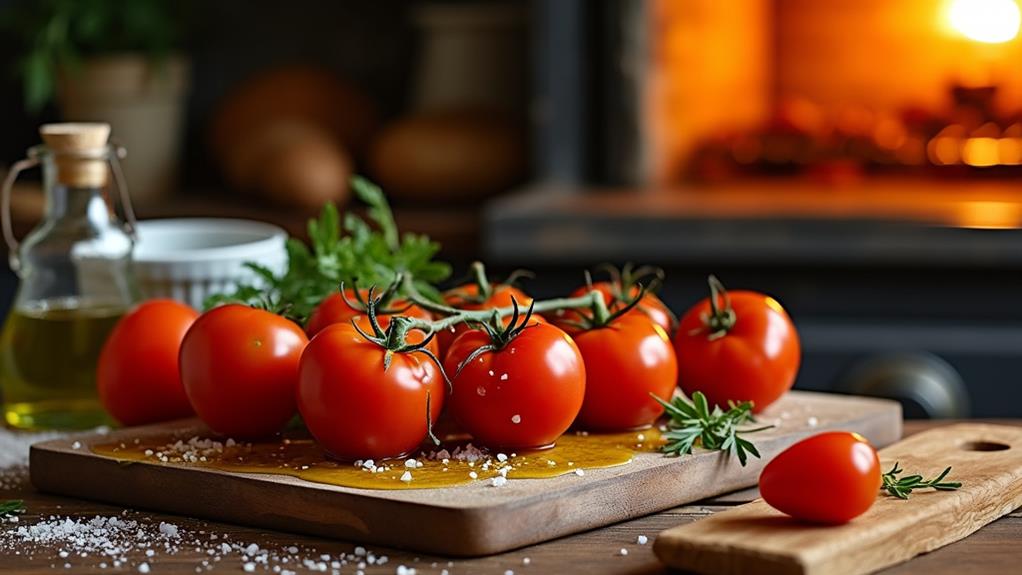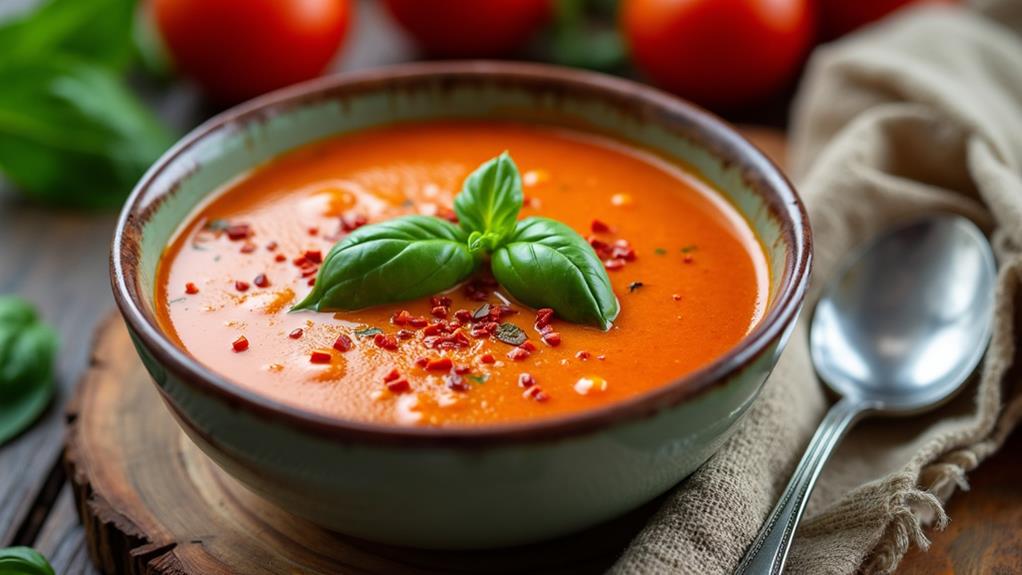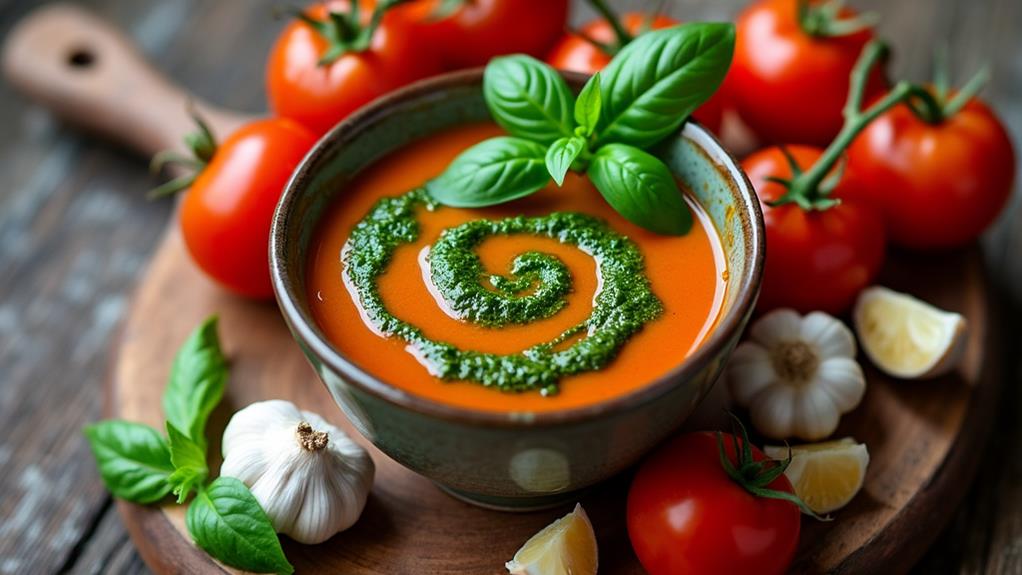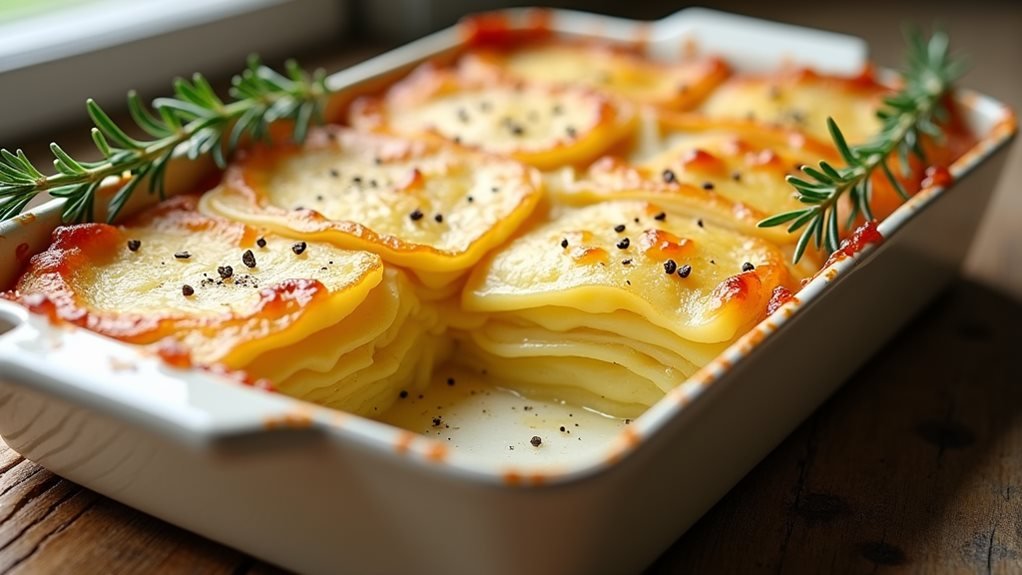Few soups capture comfort and refinement like Gordon Ramsay’s roasted tomato soup. This isn’t just any tomato bisque — it’s a masterclass in coaxing bold flavors from humble ingredients. From roasting to blending, every step reflects Ramsay’s philosophy: simple ingredients, executed with precision, yield extraordinary results.
👉 Curious if Ramsay himself enjoys it? Read: Does Gordon Ramsay Like Tomato Soup?
Why Gordon Ramsay’s Tomato Soup Stands Out
Unlike many quick stovetop tomato soups, Ramsay emphasizes roasting tomatoes, onions, and garlic to achieve a richer flavor. High heat caramelizes their natural sugars, producing a deep, smoky-sweet flavor that forms the backbone of the Soup.
This technique transforms what could be a thin, sharp tomato broth into a velvety, layered dish that balances acidity with richness. According to the California Tomato Growers Association, Roma and San Marzano varieties are prized for their low water content and high natural sweetness — both essential qualities for Soup.

Key Ingredients & Flavor Science
– Tomatoes: Roma or San Marzano give the richest base. Out of season? High-quality canned tomatoes can outperform watery fresh ones.
– Acidity Balancers: Balsamic vinegar adds complexity, while a pinch of baking soda reduces harsh acidity.
– Olive Oil: Use high-quality extra virgin olive oil — its fruitiness deepens flavor and carries aromatics.
– Cream or Alternatives: Traditional cream makes the Soup silky, but dairy-free options (cashew cream, coconut milk) provide body without overpowering the tomatoes.
👉 Looking for more Ramsay favorites? Try his Top 5 Signature Recipes.

Ramsay’s Technique — Roasting, Blending, Finishing
The genius of this Soup lies in its sequence: roast, simmer, blend.
- Roast at 400°F for 20–25 minutes, until the tomatoes blister and the onions caramelize.
- Deglaze with broth to scrape up flavorful browned bits.
- Blend until smooth with an immersion blender, then strain for a restaurant-style finish.
- Finish with cream or a dairy-free alternative, adjusting the consistency until it is velvety but not heavy.
⚡ Pro tip: If your Soup curdles, temper the cream by whisking in small amounts of hot Soup before adding it back.

Healthy & Dairy-Free Variations
– Swap cream for coconut milk (adds a subtle sweetness).
– Try cashew cream for a neutral, silky mouthfeel.
– Use vegetable stock for a vegetarian-friendly base.

Serving Suggestions & Pairings
The right garnish turns a simple soup into a memorable dish. Ramsay often finishes with pesto or Parmigiano-Reggiano, but you can mix it up:
- Artisanal bread or grilled cheese: Perfect for dipping.
- Fresh basil pesto drizzle: Adds vibrant green contrast.
- Parmigiano shards or crème fraîche: Introduces richness and tang.
- Toasted pine nuts: Provide crunch and nutty depth.
👉 Or try another cozy bowl like Velvety Pumpkin Soup.

Common Mistakes & Fixes
– Too acidic: Add a pinch of baking soda or a splash of cream.
– Too thin: Simmer longer to reduce, or stir in tomato paste.
– Grainy texture: Blend thoroughly and pass through a sieve.
– Bitter flavor: Tomatoes roasted too long; balance with sugar or balsamic.
👉 For chef-tested equipment, see our Professional Kitchen Tools.
The Role of Cayenne Pepper & Spice Options
A hallmark of Ramsay’s recipe is the subtle warmth from cayenne pepper. At 30,000–50,000 Scoville heat units, it delivers a gentle kick without overwhelming the palate. For family-friendly versions, substitute Aleppo pepper or smoked paprika.

Behind the Dish — Gordon Ramsay’s Influence on Home Cooking
Ramsay has built a career showing home cooks that refinement doesn’t have to be complicated. His tomato soup reflects this philosophy: high-heat roasting, thoughtful seasoning, and attention to detail.
Discover more about his culinary world on the official Gordon Ramsay website.

FAQs
Do I need to peel tomatoes?
Not required, but peeling improves smoothness. When blending and straining, the skins can be left intact.
How do I freeze and reheat this Soup?
Cool completely, then freeze flat in bags. Thaw overnight in the fridge. Reheat gently to prevent cream separation.
What’s the difference between creamy tomato soup and classic tomato soup?
Creamy tomato soup uses dairy (or substitutes) for a velvety mouthfeel. Classic versions rely on the natural tomato body and broth.
👉 Planning a special night? Check our 5 Valentine’s Day Appetizers.
How We Tested
We cooked this dish multiple times, adjusting acidity, cream ratios, and garnish variations. Our tests compared fresh versus canned tomatoes, dairy versus dairy-free finishes, and stovetop versus roasted methods. The roasting-first approach consistently delivered the most balanced flavor.


Gordon Ramsay Tomato Soup Recipe
Ingredients
- 10 Med-Size Vine Ripe tomatoes
- 2 cups Vegetable or chicken stock
- 6 oz Cream (optional)
- 1 red onion, finely sliced
- 2 cloves Garlic, finely sliced
- 1 tsp. Olive oil
- Salt and pepper, to taste
- 2 tsp. cayenne pepper
- 1 tsp. Sugar to intensify the sweetness
- 1 tsp. Aged balsamic vinegar
- Fresh basil leaves (for garnish, optional)
For the Sun-Dried Tomato Pesto:
- 6 oz Sun-dried tomatoes in oil
- 2 oz Pine nuts
- 2 oz Parmesan cheese, grated
- 1 tsp. Extra virgin olive oil
- Salt (optional) Parmesan may be enough
For the Welsh Rarebit:
- 50 grams butter
- 3 tablespoons flour
- 2 oz Stout beer (to taste)
- 1 tsp. Dijon mustard
- 1 tsp. Worcestershire sauce (to taste)
- 8 oz Grated mature white Cheddar cheese
- Rustic country bread
Instructions
For Roasted Tomatoes
- Preheat your oven to 180°C (356°F).
- Prepare vine tomatoes by slicing them in half and placing them in a roasting tray.
- Add sliced red onion and garlic to the tray.
- Drizzle with olive oil and season with salt, pepper, cayenne, and sugar. Splash a bit of aged balsamic vinegar on top.
- Roast in the oven for 20-25 minutes until the tomatoes are soft and caramelized.
For the Pesto:
- In a dry pan, toast pine nuts until fragrant.
- In a pestle and mortar, combine sun-dried tomatoes, toasted pine nuts, grated Parmesan cheese, and extra virgin olive oil to form a pesto.
To Finish the Soup:
- Remove tomatoes from the oven and pour vegetable or chicken stock over them, just enough to come halfway up the tomatoes.
- Break up tomatoes with a spoon and simmer for 3-4 minutes.
- Add cream if a creamier texture is desired.
- Use a stick blender to blend the soup until smooth.
For the Welsh Rarebit:
- Make a roux with butter and flour.
- Add stout beer gradually, stirring to a smooth consistency.
- Mix in Dijon mustard, a dash of Worcestershire sauce, and grated cheese until melted and combined.
- Toast both sides of a slice of rustic bread.
- Spread the cheesy mixture over the toast and place under the grill until bubbly and browned.
To Serve:
- Pour the soup into bowls, drizzle with the sun-dried tomato pesto, and garnish with fresh basil leaves if desired.
- Serve the soup alongside slices of Welsh rarebit.







